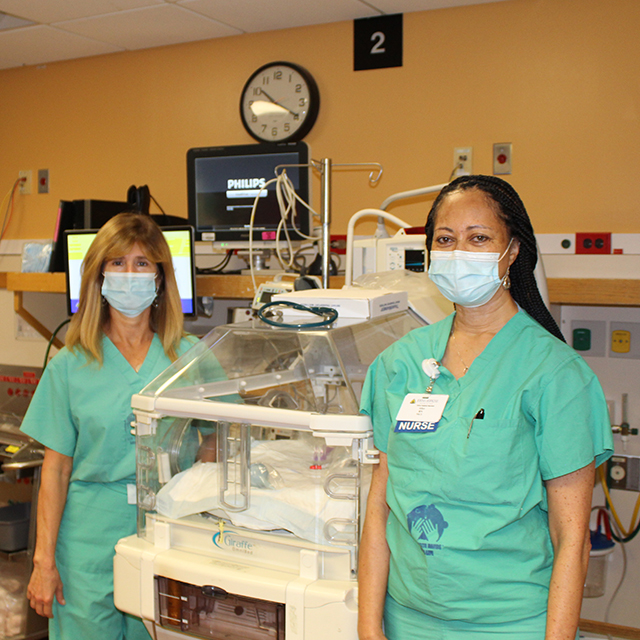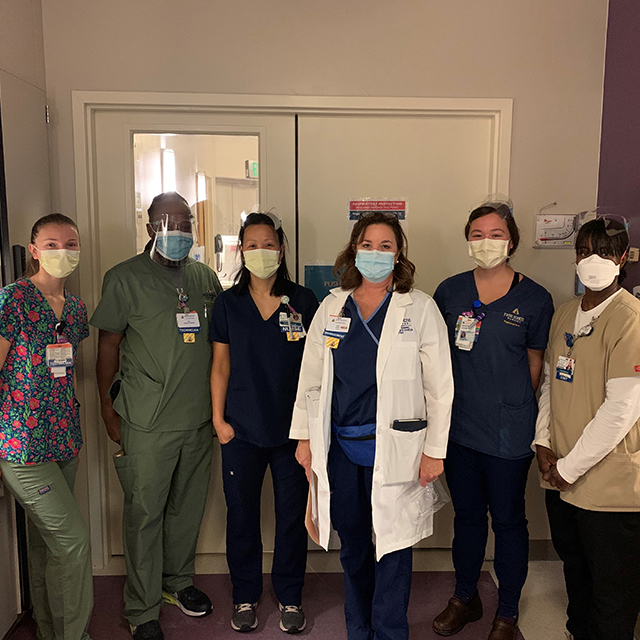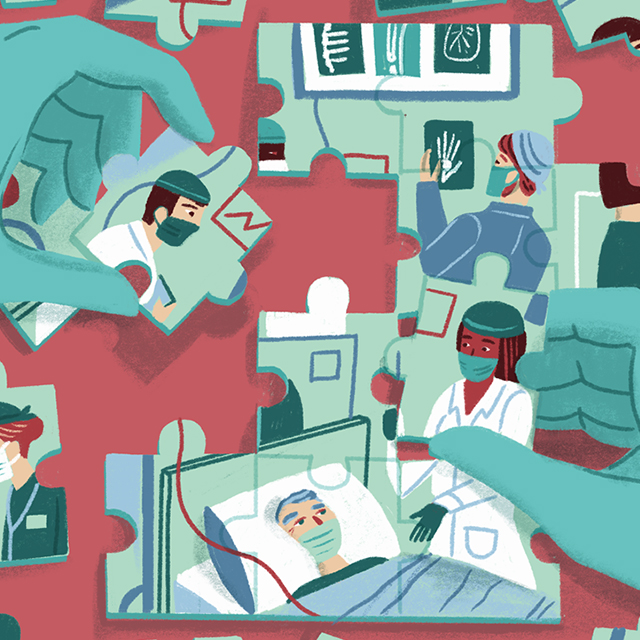This story first appeared in The Johns Hopkins Hospital 2022 Nursing Annual Report.
For bedside nurses, a career-ending injury can happen in an instant. You are trying to move or turn a patient, or catch them when they are about to fall. Then the patient, who may be delirious and outweigh you by 200–300 pounds, grabs you and wrenches your shoulder or back.
“It’s terrifying how quickly it can happen,” says Grace Nayden, who has been a nurse at The Johns Hopkins Hospital for 31 years, 30 of them on the cardiac care unit, an intensive care unit where she is a lead clinical nurse. Even though the hospital invests in special equipment to help with lifting, when things are happening fast, a nurse might not have time to use it.
Nayden has been out of commission with serious back and shoulder injuries twice, but for her, the last straw was permanently losing two of her best nurses to shoulder injuries just before COVID-19 hit. She aired her concerns at a nursing department Solution Session, a bimonthly virtual forum guided by a trained facilitator, in which small groups of nurses brainstorm about problems and possible solutions.
The issue resonated strongly with Holley Farley, nursing coordinator for clinical quality, who was told about the discussion at the Solution Session and had her own concerns about a recent patient fall that might have been prevented if the proper lift equipment had been employed. Farley helped shepherd the issue through the new nursing governance system, the Wheel. Now a Community, or work group, is investigating best practices to ensure that the lift equipment is being used, and used correctly, and is also implementing a hospital-wide solution.
“It’s a matter, not only of staff harm, but of patient harm,” Farley says. “But this would never have happened without a bedside nurse like Grace Nayden reporting a problem.”
Listening to bedside nurses has long been a priority at The Johns Hopkins Hospital, and there is an ever-growing number of ways nurses can make themselves heard.
The Governance Wheel: This is the big one, the revised nursing governance structure in which bedside nurses have the opportunity to sit on governing councils with nursing leadership at all levels. It starts with simple suggestions — “tickets” — from any staff member, and includes three levels of councils: councils representing each unit, a council that triages suggestions, and a council that determines when and how to address significant hospital-wide issues that have made it to them through the Wheel.
Solution Sessions: These intimate virtual meetings are opportunities to air everything from Nayden’s nurse injury concerns to how nurses can better care for themselves on the job. If an issue affects the entire hospital, as did Nayden’s, it can be fed directly into the Wheel.
Opinion surveys: Johns Hopkins Medicine is committed to getting feedback from all staff members, and recently selected an innovative new survey platform that allows for shorter, more frequent surveys on issues ranging from patient care to staff mental health. Results can be more easily consolidated, and issues that need to be addressed can be more quickly identified.
Virtual forums: These replace the pre-COVID-19 quarterly in-person Town Halls, and draw hundreds of nurse participants to hear updates and questions answered by leadership, including Deborah Baker, senior vice president of nursing for the Johns Hopkins Health System and vice president of nursing and patient care services for The Johns Hopkins Hospital. Questions are asked by email, and the sessions are recorded so every nurse can watch when it’s convenient.
Advisory councils: There are two of these. One represents night shift nurses, and the other, the Magnet Advisory Council, promotes the high nursing standards that earned Johns Hopkins designation as a Magnet hospital. Baker or a director of nursing attends monthly or bimonthly meetings for both.
“One of the things Deb is always listening for is what she calls ‘the pebble in the shoe,’” says Sarah Porter, director of nursing programs for the vice president’s nursing office. “Sometimes it’s just little things you think can never be fixed, but they can. At one of the pre-COVID-19 Town Halls, for instance, a night shift nurse asked why we couldn’t keep the Metro doors inside the hospital open until midnight so staff wouldn’t have to walk outside the hospital late at night, and that got fixed the next day.”
Another issue raised by a bedside nurse that led to a hospital-wide reform was how to alert and educate staff members when a patient was in end-of-life palliative care. The result is a bloom of purple butterflies on these patients’ doors, coupled with training for staff members about how to speak to and around these patients and their loved ones.
“As a nurse at Hopkins, I have always felt empowered, especially at the unit and department levels,” says Porter. “We are continually exploring new platforms and more ways to further empower nurses and close the information loop, so that all nurses know their ideas and concerns are being heard.”




